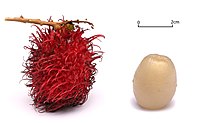
Photo from wikipedia
Abstract Bellis perennis L. is a medicinal plant in the family Compositae. It has been used as a remedy for wounds, rheumatism, eczema, eye diseases, inflammation and tonsillitis in folk… Click to show full abstract
Abstract Bellis perennis L. is a medicinal plant in the family Compositae. It has been used as a remedy for wounds, rheumatism, eczema, eye diseases, inflammation and tonsillitis in folk medicine. In the present study, 19 different extracts and two fractions were obtained from wild-grown flowers, leaves and/or in vitro -grown leaves of common daisy by using different solvents and extraction methods. Biological activities of these extracts and fractions were assessed using selected bioassays: cytotoxic activity, disc diffusion assay, radical scavenging activity (DPPH), total phenolic content, oxygen radical absorbing capacity (ORAC) and 2′,7′-dichlorofluorescin-diacetate (DCFH-DA) cell-based assays. The cytotoxic activity of extracts and fractions was investigated against human lung carcinoma (A-549) and colon adenocarcinoma (DLD-1) cells. In vitro -grown leaf extracts showed the highest cytotoxic activity against selected cell lines. Moreover, n -butanol ( n -BuOH) and ethyl acetate (EtOAc) fractions of flowers exerted high levels of cytotoxic activity. The MeOH extract and the EtOAc fraction of flowers exhibited broad-spectrum antibacterial activity against Streptococcus pyogenes , Staphylococcus aureus , Staphylococcus epidermidis , and Enterobacter cloacea . The strongest antioxidant activity was found in the EtOAc fraction of flowers with the highest amount of phenolic content and ORAC value. The MeOH extract of flowers showed strong anti-inflammatory activity on RAW 264.7 macrophages. The amount of the chosen 22 phenolic compounds in dichloromethane (DCM), MeOH extracts, n -BuOH and EtOAc fractions of field-grown flowers was detected using LC–ESI–MS/MS. The results of these studies support the potential use of B. perennis for wounds, rheumatism, inflammation, cancer and eye diseases.
Journal Title: Journal of Herbal Medicine
Year Published: 2017
Link to full text (if available)
Share on Social Media: Sign Up to like & get
recommendations!